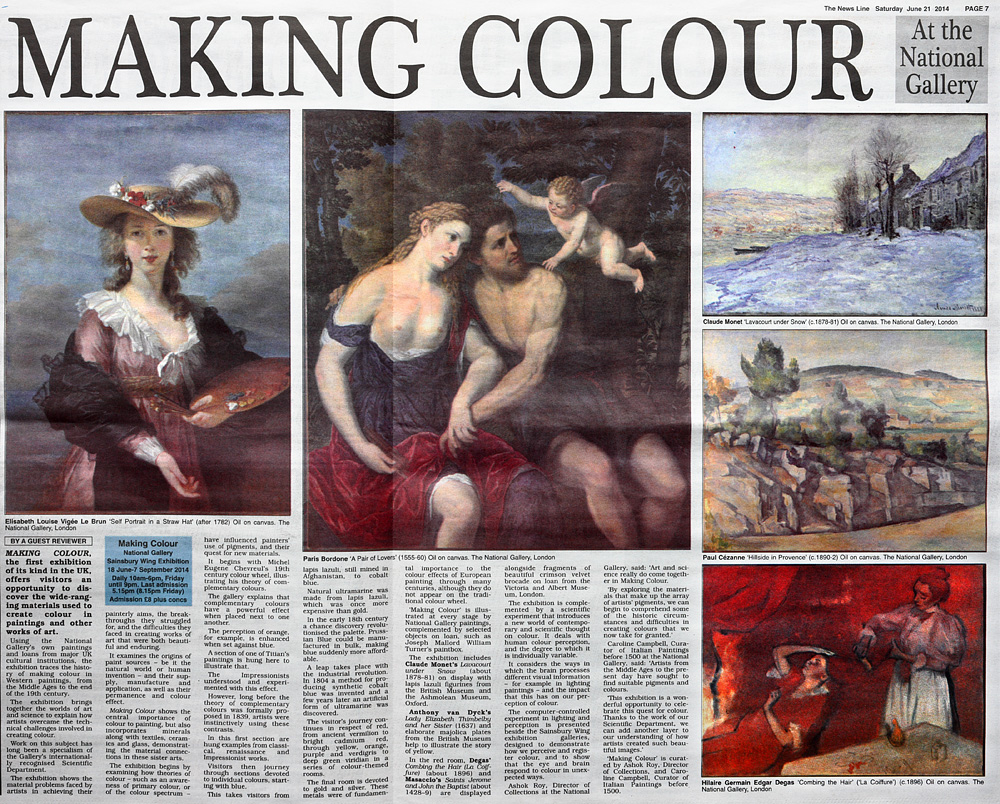 |
|
The News Line
MAKING COLOUR - At the National Gallery Making Colour National Gallery Sainsbury Wing Exhibition 18 June- Daily
Friday until Admission £8 plus concs BY A GUEST REVIEWER MAKING COLOUR, the first exhibition of its kind in
the Using the National Gallery's own paintings and
loans from major The exhibition brings together the worlds of art and science to explain how artists overcame the technical challenges involved in creating colour. Work on this subject has long been a specialism of the Gallery's internationally recognised Scientific Department. The exhibition shows the material problems faced by artists in achieving their painterly aims, the breakthroughs they struggled for, and the difficulties they faced in creating works of art that were both beautiful and enduring. It examines the origins of paint sources - be it the natural world or human invention - and their supply, manufacture and application, as well as their permanence and colour effect. Making Colour shows the central Importance of colour to painting, but also incorporates minerals along with textiles, ceramics and glass, demonstrating the material connections in these sister arts. The exhibition begins by examining how theories of colour - such as an awareness of primary colour, or of the colour spectrum - have influenced painters' use of pigments, and their quest for new materials. It begins with Michel Eugene Chevreul's 19th century colour wheel, illustrating his theory of complementary colours. The gallery explains that complementary colours have a powerful effect when placed next to one another. The perception of orange, for example, is enhanced when set against blue. A section of one of Titian's paintings is hung here to illustrate that. The Impressionists understood and experimented with this effect. However, long before the theory of complementary colours was formally proposed in 1839, artists were instinctively using these contrasts. In this first section are hung examples from classical, renaissance and Impressionist works. Visitors then journey through sections devoted to individual colours, starting with blue. This takes visitors from lapis lazuli, still mined
in Natural ultramarine was made from lapis lazuli, which was once more expensive than gold. In the early 18th century a chance discovery revolutionised the palette. Prussian Blue could be manufactured in bulk, making blue suddenly more affordable. A leap takes place with the industrial revolution. In 1804 a method for producing synthetic cobalt blue was invented and a few years later an artificial form of ultramarine was discovered. The visitor's journey continues in respect of red, from ancient vermilion to bright cadmium red, through yellow, orange, purple and verdigris to deep green viridian in a series of colour-themed rooms. The final room is devoted. to gold and silver. These metals were of fundamental importance to the colour effects of European painting through many centuries, although they do not appear on the traditional colour wheel. 'Making Colour' is illustrated at every stage by National Gallery paintings, complemented by selected objects on loan, such as Joseph Mallord Willlam Turner's paintbox. The exhibition includes
Claude Monet's Lavacourt under Snow (about 1878-81) on display with lapis
lazuli figurines from the Anthony van Dyck's Lady
Elizabeth Thimbelby and her Sister (1637) and elaborate majolica plates
from the In the red room, Degas' Combing the Hair (La Coiffure) (about 1896) and Masaccio's Saints Jerome and John the Baptist (about 1428-9) are displayed alongside fragments of beautiful crimson velvet brocade on loan from the Victoria and Albert Museum, London. The exhibition is complemented by a scientific experiment that introduces a new world of contemporary and scientific thought on colour. It deals with human colour perception, and the degree to which it is individually variable. It considers the ways in which the brain processes different visual information - for example in lighting paintings - and the impact that this has on our perception of colour. The computer-controlled experiment in lighting and perception is presented beside the Sainsbury wing exhibition galleries, designed to demonstrate how we perceive and register colour, and to show that the eye and brain respond to colour in unexpected ways. Ashok Roy, Director of Collections at the National Gallery, said: 'Art and science really do come together in Making Colour. 'By exploring the materials that make up the array of artists' pigments, we can begin to comprehend some of the historic circumstances and difficulties in creating colours that we now take for granted.' Caroline Campbell, Curator of Italian Paintings before 1500 at the National Gallery, said: 'Artists from the Middle Ages to the present day have sought to find suitable pigments and colours. This exhibition is a wonderful opportunity to celebrate this quest for colour. Thanks to the work of our Scientific Department, we can add another layer to our understanding of how artists created such beautiful images.' 'Making Colour' Is curated by Ashok Roy, Director of Collections, and Caroline Campbell, Curator of Italian Paintings before. 1500. |